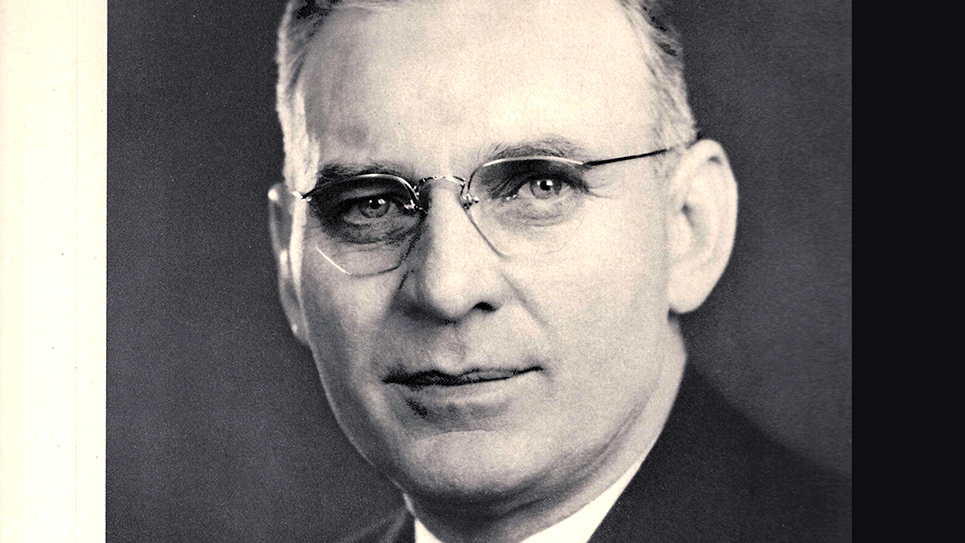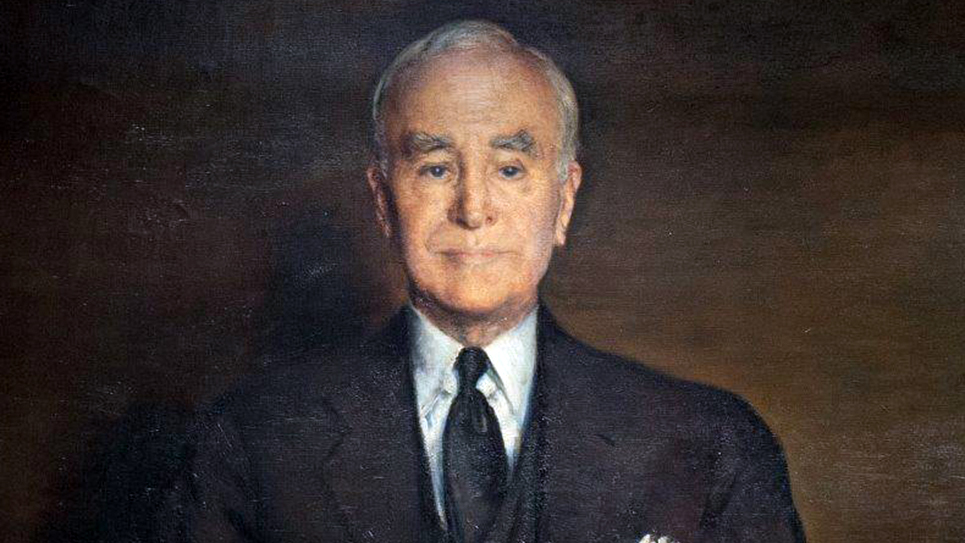Statesman from the North Star State: Edward J Thye of Minnesota
Politics is perhaps the most fickle of mistresses. The one thing one can always rely upon to change is the times. Even the most enduring of officeholders are frequently faced with the changing of the times and what was once highly popular in the past becomes not as well-liked in the present. History is littered with those who have enjoyed successful political careers only to close out that tenure with an unexpected and final defeat.
Edward John Thye was a tall, distinguished-looking fellow, who rather looked like a successful small town businessman or shopkeeper rather than the son of the soil he was. With his carefully combed hair and glasses, Thye looked positively reliable and able, which he also was. A successful farmer and a man willing to work hard, Thye methodically climbed the political ladder in his home state of Minnesota. Ed Thye was selected to serve as deputy commissioner of agriculture, a position of some importance in a state which was notable for its heavy reliance upon agribusiness. Thye then was elected lieutenant governor, an office that really only matters to the general public when a governor either quits or dies in office.
Governor Harold Stassen, once considered the “wonder boy” of politics, did exactly that, abruptly resigning his office to serve in the armed forces during the Second World War. There were those crass enough to say that Stassen, who harbored presidential ambitions (and would become something of a laughingstock for his perennial candidacies for public office), believed fighting for his country would add to his luster as a prospective presidential candidate.
When Harold Stassen resigned as Minnesota’s chief executive on April 27, 1943, Edward J. Thye became governor. Thye was easily elected to a term of his own in 1944 and demonstrated he was popular with the people he represented. Ed Thye would be the last governor of Minnesota to come from a farming background.
The ultimate test of Edward J. Thye’s personal and political popularity came two years later when former Governor Harold Stassen nudged Thye into the Republican primary for the United States Senate to take on the most formidable politician in the North Star State, Henrik Shipstead.
Shipstead had been born in Norway and still spoke with a distinctly discernable Norwegian accent. Tall, with a full head of white hair and usually chomping a cigar, Shipstead looked very much like Hollywood’s ideal version of a United States senator. Henrik Shipstead had burst onto the political scene with a failed campaign for governor, but came back in 1922 to win a seat in the U. S. Senate on a third party ticket as the candidate of the Farmer-Labor Party, beating a Republican incumbent and the Democratic nominee who ran a poor third. Shipstead came to the United States Senate with the reputation of being a dangerous radical; by the time he left office, he was viewed as something akin to a hidebound reactionary, proving yet again times do change.
Shipstead accomplished the same feat twice more, winning as a third party candidate and the nominee of the Farmer-Labor Party again in the 1928 and 1934 elections. A shrewd and wily politician, by 1940 Henrik Shipstead sensed the Farmer-Labor Party had peaked (it would later merge with Minnesota’s Democrats) and he ran again as a Republican that year and won easily. By 1946, the 65-year-old former dentist was one of the leading and loudest isolationists in the United States Senate. While Shipstead most certainly did not view himself as an isolationist, the media of the day labeled him as one and it stuck, especially when the senator was only one of two members who voted against the United States participating in the United Nations. While he campaigned hard, the old Norwegian lost badly to Governor Ed Thye, who won quite nearly 60% of the votes cast. Thye won by about the same margin in the general election.
When a candidate beats an officeholder deemed by the news media and the public as something of an institution, it never fails to attract considerable attention and usually an equal amount of political speculation. A reputation as a “giant killer” never hurts at the polls. If Henrik Shipstead had been perceived to be a conservative Republican by the time he had been defeated, Ed Thye was viewed as something of a liberal Republican.
Like Shipstead, Edward J. Thye was Norwegian, as his parents had come to Minnesota as immigrants. Unlike Henrik Shipstead, Thye had risen to the political heights by having been the handpicked choice of Harold Stassen who was at the height of his own political influence and popularity in Minnesota. Whatever impression one might have of Edward J. Thye’s political rise, he remained his own man. Thye had been a farmer and according to the Minneapolis Star, “a good one.”
Ed Thye won a footnote in political history for his role at the 1952 Republican National Convention, which was witness to a heated battle between Senator Robert Taft of Ohio and former General Dwight D. Eisenhower for the GOP presidential nomination. Thye’s political mentor, former Governor Harold Stassen, was also a candidate for the nomination, but his candidacy was not taken seriously outside of Minnesota. Still, Stassen had the support of the Minnesota delegation to the GOP national convention and the contest was close enough between Taft and Eisenhower that it mattered. Stassen encountered a revolt by delegates to the convention who were committed to his candidacy for the first ballot. The former governor pleaded, almost begged, his fellow Minnesotans to stick with him, but three delegates, including Governor Elmer Anderson, decided they would vote for Eisenhower instead. Some of the bolting delegates insisted Eisenhower could lose the Republican nomination if they failed to act and voted for a favorite son candidate who had no chance to win. With tears in his eyes, Harold Stassen released the delegates from their pledge of support.
Congressman Walter Judd, a former missionary to China, hurried to the speaker’s podium where Joe Martin of Massachusetts presided. Judd told Martin to recognize Minnesota as soon as the roll call came to an end. Senator Ed Thye shouldered his way through a crowd and grabbed the microphone, shouting, “Mr. Chairman! Mr. Chairman!” Joe Martin gestured with the gavel and recognized “the delegate from Minnesota.”
“Mr. Speaker,” Thye said, “Minnesota wishes to change its vote to 28 for Eisenhower.”
With that, the convention erupted into pandemonium. Dwight D. Eisenhower had just become the Republican nominee for president of the United States. Eisenhower won the general election handily and the GOP won both houses of Congress. Edward Thye was reelected to the United States Senate as well. Senator Thye’s prominence in making Dwight D. Eisenhower the GOP nominee and the occupant of the White House certainly didn’t hurt him in Washington, D.C.
Robert “Bob” Short, a blustery trucking company executive who would remain active in politics for decades to come, had been the leader of the Kefauver campaign in Minnesota. In 1957, Bob Short traveled to Washington, D.C. to encourage Democrats in Minnesota’s congressional delegation to start planning to settle on a challenger to popular incumbent Senator Edward J. Thye. Short insisted the formidable senator could be beaten. Short warned if nobody stepped up to challenge the senator, he would run himself. Bob Short was something of a controversial figure inside Minnesota’s Democratic Farmer Labor Party and the idea of his becoming the DFL candidate for the United States Senate in 1958 was not at all appealing to many party activists. As one reporter for the St. Paul Recorder wrote, that notion “sent shivers down the backs of some DFL candidates” who only forgot their usual “antipathy” to Bob Short when campaigns needed money. Much of the focus fell on two members of the congressional delegation to carry the DFL banner in the 1958 general election: John Blatnik, the longtime congressman from Minnesota’s “Iron Range,” and Eugene J. McCarthy, a former economics professor who had first been elected to Congress in the 1948 Democratic sweep, representing the Twin Cities.
Bob Short became quite wealthy and was largely known for his ownership of the Minnesota/Los Angeles Lakers basketball team and the Washington/Texas Senators baseball team. Twenty years after the 1958 campaign, Bob Short would get his brief moment of political glory when he upset Congressman Donald Fraser for the Senate seat of the late Hubert Humphrey in a 1978 special election that saw both of Minnesota’s seats in the United States Senate on the ballot as Walter Mondale had resigned to become vice president under Jimmy Carter. Minnesotans shocked the nation and the DFL when they elected two Republicans.
Eventually, two Democrats competed for the right to face Ed Thye in the 1958 general election. Eugenie Anderson had long been active in Minnesota’s DFL and had also served as the ambassador to Denmark in 1949 where she remained for four years. Anderson resigned with the election of Dwight Eisenhower and went home to Minnesota. Anderson fought a lively battle with Congressman Eugene McCarthy for the DFL Party nomination to face Senator Ed Thye in the general election. McCarthy won that contest and was initially perceived to be the underdog in the Senate race.
Timing is a main ingredient in the recipe for political success and 1958 proved to be one of the best Democratic years in history. The country was in the midst of a serious recession and the policies of Ezra Taft Benson, Eisenhower’s Secretary of Agriculture, were becoming increasingly unpopular with farm voters in particular. Farm policies have usually had much to do with the failure or success of congressional incumbents in agricultural states. Ed Thye was no different and the unpopularity of the Benson policies and the deepening recession was a heavy load for any candidate to carry into a general election. While Thye ran very well in the rural and traditionally more Republican counties of Minnesota, Eugene McCarthy was elected on a rising tide of urban ballots from the Twin Cities. Thye congratulated his successor and finished out the few months remaining in his term of office.
Following his defeat for reelection in 1958, Ed Thye had no desire to remain in Washington, D.C., much less become a lobbyist. Instead, he resided on his 563-acre farm in Northfield where he actively worked until two years before his death. It was then Thye leased the land following a bout with double pneumonia and a heart attack. Thye assumed the comfortable role of many ex-officeholders, that of party elder statesman, and the former senator could be spotted at GOP events in Minnesota.
Thye, had he been in better health, might well have accepted some role in the Nixon administration in 1969, but by that time the former senator was seriously ailing from emphysema. Thye died from the disease on August 28, 1969, at the age of 73. Death found Edward J. Thye where his heart was always happiest, his farm in Northfield.
When Ed Thye died, the usual editorials about his life were published throughout the state he had run as governor and represented in the United States Senate. The Minneapolis Star noted Thye’s participation “in local civic, agricultural and political movements.” Once upon a time, it was the traditional way to become involved in one’s own community and the pages of local political history are dotted with “joiners.” Always earnest, the Star lauded the former senator for having been “the modest gentleman” yet one who “still vigorously espoused the causes he believed in.” Thye had been a leader of the powerful farmer bloc while in the Senate and his surprising defeat in 1958 was in part due to what the Minneapolis Star noted as “the nation’s problems were becoming urbanized and Sen. Thye’s defeat in 1958 by Eugene McCarthy in part reflected this change.”
Events, issues, concerns, values and people always change with the inexorable march of time.







